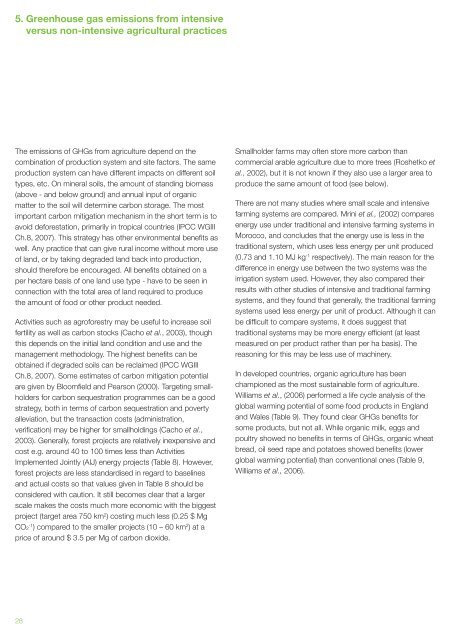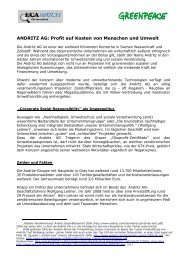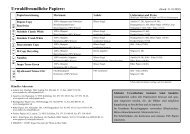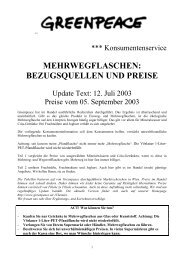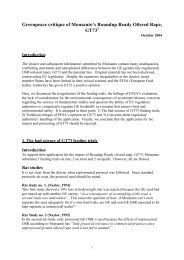Cool Farming: Climate impacts of agriculture and mitigation potential
Cool Farming: Climate impacts of agriculture and mitigation potential
Cool Farming: Climate impacts of agriculture and mitigation potential
Create successful ePaper yourself
Turn your PDF publications into a flip-book with our unique Google optimized e-Paper software.
5. Greenhouse gas emissions from intensive<br />
versus non-intensive agricultural practices<br />
The emissions <strong>of</strong> GHGs from <strong>agriculture</strong> depend on the<br />
combination <strong>of</strong> production system <strong>and</strong> site factors. The same<br />
production system can have different <strong>impacts</strong> on different soil<br />
types, etc. On mineral soils, the amount <strong>of</strong> st<strong>and</strong>ing biomass<br />
(above - <strong>and</strong> below ground) <strong>and</strong> annual input <strong>of</strong> organic<br />
matter to the soil will determine carbon storage. The most<br />
important carbon <strong>mitigation</strong> mechanism in the short term is to<br />
avoid deforestation, primarily in tropical countries (IPCC WGIII<br />
Ch.8, 2007). This strategy has other environmental benefits as<br />
well. Any practice that can give rural income without more use<br />
<strong>of</strong> l<strong>and</strong>, or by taking degraded l<strong>and</strong> back into production,<br />
should therefore be encouraged. All benefits obtained on a<br />
per hectare basis <strong>of</strong> one l<strong>and</strong> use type - have to be seen in<br />
connection with the total area <strong>of</strong> l<strong>and</strong> required to produce<br />
the amount <strong>of</strong> food or other product needed.<br />
Activities such as agr<strong>of</strong>orestry may be useful to increase soil<br />
fertility as well as carbon stocks (Cacho et al., 2003), though<br />
this depends on the initial l<strong>and</strong> condition <strong>and</strong> use <strong>and</strong> the<br />
management methodology. The highest benefits can be<br />
obtained if degraded soils can be reclaimed (IPCC WGIII<br />
Ch.8, 2007). Some estimates <strong>of</strong> carbon <strong>mitigation</strong> <strong>potential</strong><br />
are given by Bloomfield <strong>and</strong> Pearson (2000). Targeting smallholders<br />
for carbon sequestration programmes can be a good<br />
strategy, both in terms <strong>of</strong> carbon sequestration <strong>and</strong> poverty<br />
alleviation, but the transaction costs (administration,<br />
verification) may be higher for smallholdings (Cacho et al.,<br />
2003). Generally, forest projects are relatively inexpensive <strong>and</strong><br />
cost e.g. around 40 to 100 times less than Activities<br />
Implemented Jointly (AIJ) energy projects (Table 8). However,<br />
forest projects are less st<strong>and</strong>ardised in regard to baselines<br />
<strong>and</strong> actual costs so that values given in Table 8 should be<br />
considered with caution. It still becomes clear that a larger<br />
scale makes the costs much more economic with the biggest<br />
project (target area 750 km 2 ) costing much less (0.25 $ Mg<br />
CO2 -1 ) compared to the smaller projects (10 – 60 km 2 ) at a<br />
price <strong>of</strong> around $ 3.5 per Mg <strong>of</strong> carbon dioxide.<br />
28<br />
Smallholder farms may <strong>of</strong>ten store more carbon than<br />
commercial arable <strong>agriculture</strong> due to more trees (Roshetko et<br />
al., 2002), but it is not known if they also use a larger area to<br />
produce the same amount <strong>of</strong> food (see below).<br />
There are not many studies where small scale <strong>and</strong> intensive<br />
farming systems are compared. Mrini et al., (2002) compares<br />
energy use under traditional <strong>and</strong> intensive farming systems in<br />
Morocco, <strong>and</strong> concludes that the energy use is less in the<br />
traditional system, which uses less energy per unit produced<br />
(0.73 <strong>and</strong> 1.10 MJ kg -1 respectively). The main reason for the<br />
difference in energy use between the two systems was the<br />
irrigation system used. However, they also compared their<br />
results with other studies <strong>of</strong> intensive <strong>and</strong> traditional farming<br />
systems, <strong>and</strong> they found that generally, the traditional farming<br />
systems used less energy per unit <strong>of</strong> product. Although it can<br />
be difficult to compare systems, it does suggest that<br />
traditional systems may be more energy efficient (at least<br />
measured on per product rather than per ha basis). The<br />
reasoning for this may be less use <strong>of</strong> machinery.<br />
In developed countries, organic <strong>agriculture</strong> has been<br />
championed as the most sustainable form <strong>of</strong> <strong>agriculture</strong>.<br />
Williams et al., (2006) performed a life cycle analysis <strong>of</strong> the<br />
global warming <strong>potential</strong> <strong>of</strong> some food products in Engl<strong>and</strong><br />
<strong>and</strong> Wales (Table 9). They found clear GHGs benefits for<br />
some products, but not all. While organic milk, eggs <strong>and</strong><br />
poultry showed no benefits in terms <strong>of</strong> GHGs, organic wheat<br />
bread, oil seed rape <strong>and</strong> potatoes showed benefits (lower<br />
global warming <strong>potential</strong>) than conventional ones (Table 9,<br />
Williams et al., 2006).


